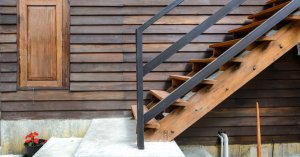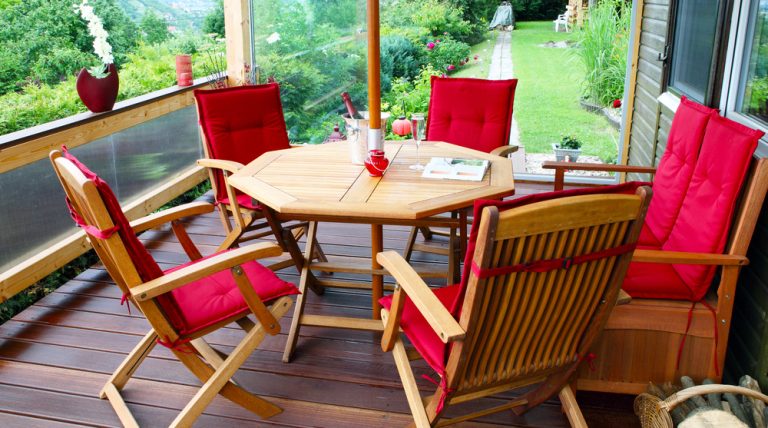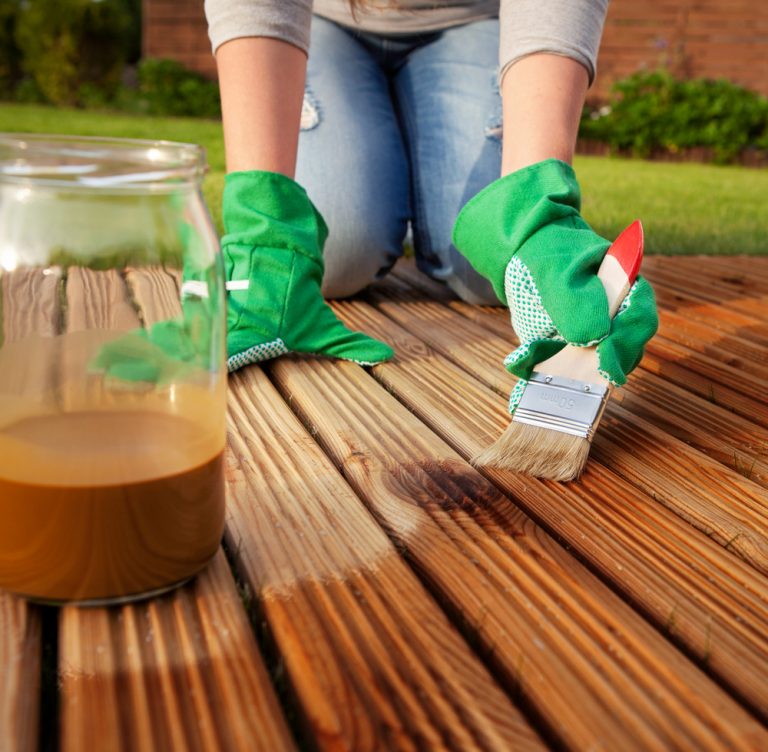The Best Woods for Your Home's Exterior

If we’re going to decorate our garden or terrace with wood, we have to keep in mind that not all wood is resistant to different atmospheric agents. That’s why we should only use those woods that are known to last outdoors.
It’s obvious that wood looks great on the exterior of homes. It gives the home a warm and comfortable look. You can put it on both the floors and walls, as well as having wooden tables and chairs. First, you have to know the climate in your area well and then choose the wood that is most appropriate for it.
There are different types of wood for outdoors on the market. But which are the best and most resistant? We’ll give you a list of them so you can choose the one that best suits your needs.
Pinewood
Pinewood is the most common. It’s fairly economical but has little resistance and durability in adverse weather conditions like sun, rain or frost. So, it needs more protection and maintenance to make it more resistant to atmospheric changes.
We recommend carrying out a maintenance check every six months to keep the quality intact. This will help make it resistant to humidity and insects.
Red pine
Red pine is a tree that’s originally from Russia and that belongs to the Scots pine group. It has a reddish tone with very marked rings. Its grain sizes are from medium to fine, with straight fibers and sometimes small and isolated knots.
This type of wood is sensitive to fungi and insect attacks. However, it’s very resistant to flexion, compression, and traction, which means it can be used for projects that need a bit of movement or bending.
It’s very useful for making decorative plates and rustic furniture.

Tropical woods
Tropical woods are more resistant than pine wood without the need for any treatment. So, they’re more commonly used outdoors.
However, they’re not as cheap as pine. But their high durability and low maintenance make up for this.
It’s recommended to add special oils to this wood from time to time so it doesn’t lose its properties.
Bangkirai wood
This is a tropical wood from Southeast Asia. It’s dense and has a high resistance to fungi. It also has its own protection, so it’s not necessary to apply treatment to it.
It stands out for having a lighter color than other woods, and it’s not too pricey.

IPE wood
This wood comes from Brazil and Bolivia. It’s dense, very weather resistant, and won’t get damaged easily.
It has an intense reddish hue and resists insect and fungi attacks well.
Teak wood
This is a hard and resistant wood. That’s why it’s one of the most expensive woods on the market. It has a very elegant appearance and suits all kinds of terraces and outdoor areas.
In addition to its resistance, another great feature of this wood is its self-defense when attacked by termites, fungi or other harmful organisms.
It may be one of the finest woods that exist. It can last between 10 to 15 years, which is why people want to use it for furniture and decks.
Laminated fir woods
This wood is far more weather resistant than pine.
It also suffers fewer deformations, cracks, and loss of knots. However, it needs a protective treatment for biotic and external agents.
Maintenance for exterior woods
Atmospheric agents attack all woods in one way or another.
Humidity, for example. causes swelling and insect and fungi attacks. The sun also has a degrading effect that gives the wood a grayish color. That, as well as sudden climatic changes, causes the appearance of cracks and breaks in the wood.
Specific treatments made for wood are key to protecting it from all these biotic and atmospheric agents.

One of the most common treatments is known as autoclave. This consists of putting the wood in a vacuum chamber where it’s injected with a protective treatment. This treatment will give the wood a greenish color.
We should always be careful when it comes to choosing the wood for the exterior of our homes. Remember that all wood needs a special and periodic treatment using special oils. This keeps it from losing its shine and keeps it soft to the touch.
If we’re going to decorate our garden or terrace with wood, we have to keep in mind that not all wood is resistant to different atmospheric agents. That’s why we should only use those woods that are known to last outdoors.
It’s obvious that wood looks great on the exterior of homes. It gives the home a warm and comfortable look. You can put it on both the floors and walls, as well as having wooden tables and chairs. First, you have to know the climate in your area well and then choose the wood that is most appropriate for it.
There are different types of wood for outdoors on the market. But which are the best and most resistant? We’ll give you a list of them so you can choose the one that best suits your needs.
Pinewood
Pinewood is the most common. It’s fairly economical but has little resistance and durability in adverse weather conditions like sun, rain or frost. So, it needs more protection and maintenance to make it more resistant to atmospheric changes.
We recommend carrying out a maintenance check every six months to keep the quality intact. This will help make it resistant to humidity and insects.
Red pine
Red pine is a tree that’s originally from Russia and that belongs to the Scots pine group. It has a reddish tone with very marked rings. Its grain sizes are from medium to fine, with straight fibers and sometimes small and isolated knots.
This type of wood is sensitive to fungi and insect attacks. However, it’s very resistant to flexion, compression, and traction, which means it can be used for projects that need a bit of movement or bending.
It’s very useful for making decorative plates and rustic furniture.

Tropical woods
Tropical woods are more resistant than pine wood without the need for any treatment. So, they’re more commonly used outdoors.
However, they’re not as cheap as pine. But their high durability and low maintenance make up for this.
It’s recommended to add special oils to this wood from time to time so it doesn’t lose its properties.
Bangkirai wood
This is a tropical wood from Southeast Asia. It’s dense and has a high resistance to fungi. It also has its own protection, so it’s not necessary to apply treatment to it.
It stands out for having a lighter color than other woods, and it’s not too pricey.

IPE wood
This wood comes from Brazil and Bolivia. It’s dense, very weather resistant, and won’t get damaged easily.
It has an intense reddish hue and resists insect and fungi attacks well.
Teak wood
This is a hard and resistant wood. That’s why it’s one of the most expensive woods on the market. It has a very elegant appearance and suits all kinds of terraces and outdoor areas.
In addition to its resistance, another great feature of this wood is its self-defense when attacked by termites, fungi or other harmful organisms.
It may be one of the finest woods that exist. It can last between 10 to 15 years, which is why people want to use it for furniture and decks.
Laminated fir woods
This wood is far more weather resistant than pine.
It also suffers fewer deformations, cracks, and loss of knots. However, it needs a protective treatment for biotic and external agents.
Maintenance for exterior woods
Atmospheric agents attack all woods in one way or another.
Humidity, for example. causes swelling and insect and fungi attacks. The sun also has a degrading effect that gives the wood a grayish color. That, as well as sudden climatic changes, causes the appearance of cracks and breaks in the wood.
Specific treatments made for wood are key to protecting it from all these biotic and atmospheric agents.

One of the most common treatments is known as autoclave. This consists of putting the wood in a vacuum chamber where it’s injected with a protective treatment. This treatment will give the wood a greenish color.
We should always be careful when it comes to choosing the wood for the exterior of our homes. Remember that all wood needs a special and periodic treatment using special oils. This keeps it from losing its shine and keeps it soft to the touch.







